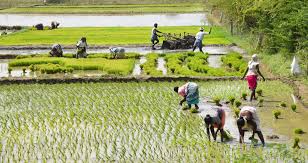Record paddy planting a blow to Punjab’s push for diversification
By Anju Agnihotri Chaba
In a setback to the crop diversification effort of over four decades in Punjab, the area under paddy cultivation has surged to an unprecedented 32.23 lakh hectares, including 6.39 lakh hectares devoted to Basmati rice, till July 30 this year, which was 31.79 lakh hectares, including 5.96 lakh hectares under Basmati cultivation, in the corresponding period last year, the Punjab Agriculture Department fields’ reports reveal.
Decades of Diversification Efforts
More than forty years ago, the crop diversification plan in Punjab was mooted, aiming to reduce the area under water-intensive paddy by promoting alternative crops like maize, cotton, Basmati, sugarcane kharif season pulses, etc. Since then, successive governments in the state set targets to cut areas under paddy cultivation and increase the cultivation of alternative crops, but despite their efforts, the reality is starkly different — the acreage under paddy cultivation rises steadily.
In the 1980s, for the first time, attempts were made to address this issue.
In 2002, the Congress-led Punjab government introduced contract farming to reduce the area under paddy cultivation, but it failed.
In 2012-13, late chief minister Parkash Singh Badal led the SAD-BJP government to formulate a new agriculture policy to divert nearly 1.2 million hectares from paddy cultivation to high-value and alternative crops. It was then proposed that kharif maize should be a major component of the crop diversification plan, and occupy around 5.5 lakh hectares, 45 per cent of the land diverted from paddy. However, the area under alternative crops diminished after some time the paddy acreage increased steadily.
Declining Area Under Alternative Crops
Experts recommended bringing the paddy area, including Basmati, down below 20 lakh hectares and increasing the area under alternative crops by more than 20 lakh hectares, but Punjab Agriculture Department data shows a sharp decline in the cultivation of a few alternative crops like cotton, while the cultivation of crops like maize and sugarcane not showing any significant increase from the existing area under cultivation.
Even as the state government claims to bring 10 lakh hectares under Basmati, the combined area under alternative crops like Basmati, cotton, maize and sugarcane did not reach beyond 10 lakh hectares in most of the years in the past decade. Only four years in the past decade recorded the combined area under alternative crops either 10 lakh hectares or above. Besides, most of the area under the Kharif season is occupied by paddy only, which has an assured Minimum Support Price (MSP) and is procured by the government unlike other crops, which the farmers are forced to sell at the rate fixed by private players in the open market.
The area under cotton has shrunk from 3.35 lakh hectares in 2015 to just 99,718 hectares this year, highlighting challenges such as pest attacks (White fly and Pink Bollworm pets) and fluctuating market prices, among others, faced by cultivators.
The maize cultivation has, too, not seen any significant increase from 1.26 lakh hectares in 2015-16 to 1.18 lakh hectares till July 23 in 2024-25, pointing to reduced support and interest in maize farming.
Although the area under sugarcane fluctuated, it generally remained below earlier levels. From 92,000 hectares in 2015-16, it has varied but only reached 94,558 hectares in 2024-25, indicating instability and insufficient growth.
Basmati is also a rice crop, but its cycle is almost one month shorter than the paddy (non-Basmati rice) and less water-intensive. It has shown a decrease from 7.63 lakh hectares in 2015-16 to 6.39 lakh hectares in 2024-25.
Implications For Punjab’s Agriculture
The continued expansion of paddy cultivation has aggravated water scarcity issues in Punjab, which is already grappling with depleting groundwater. The increased area under paddy, being a water-intensive crop, places additional pressure on the state’s water resources, affecting overall agricultural sustainability. According to the Central Ground Water Board report 2017-18, by 2039, there will be a crisis in agriculture due to water because one will have to dig up to 1,000 feet to get water.
“Economically, while paddy comes under MSP, the decline in alternative crops limits income diversification for farmers and reduces the state’s agricultural resilience. The persistent focus on paddy highlights the need for more effective strategies and support systems to revitalise alternative crop sectors and achieve true agricultural diversification,” said agriculture expert and former director of the Agriculture Department Dr Swatantra Kumar Airy.
Renowned economist and agriculture expert Sardara Singh Johal said efforts to reduce the area under the paddy cultivation are insufficient, as Punjab’s record-high paddy acreage this year highlights the challenges faced by the state’s crop diversification strategy. “Policymakers, agricultural experts, and farmers must urgently reassess and strengthen their efforts to balance the paddy cultivation with a more diverse and sustainable agricultural approach. The trends from recent years serve as a crucial reminder to the Punjab’s agricultural future,” Johal emphasized.
Having advocated for the diversification of paddy fields to other crops for the past 40 years, Johal pointed out that “the state is experiencing a severe water crisis due to the over-exploitation of its aquifers, resulting in the drying of upper aquifers. Everyone is exploiting and mistreating the state regarding its water resources, and every Punjabi feels this injustice. Punjab contributes millions of tonnes of rice and wheat to the central pool every year, and groundwater is a critical resource for this production. The over-extraction of groundwater, primarily for paddy cultivation, has left the state grappling with the threat of desertification.”
Johal added that “this small state is not only feeding the entire country but also helping the nation earn substantial revenue from wheat and rice exports, and therefore, it is imperative to assist Punjab in breaking out of the paddy-wheat cycle”.
This article has been republished from The Indian Express.

